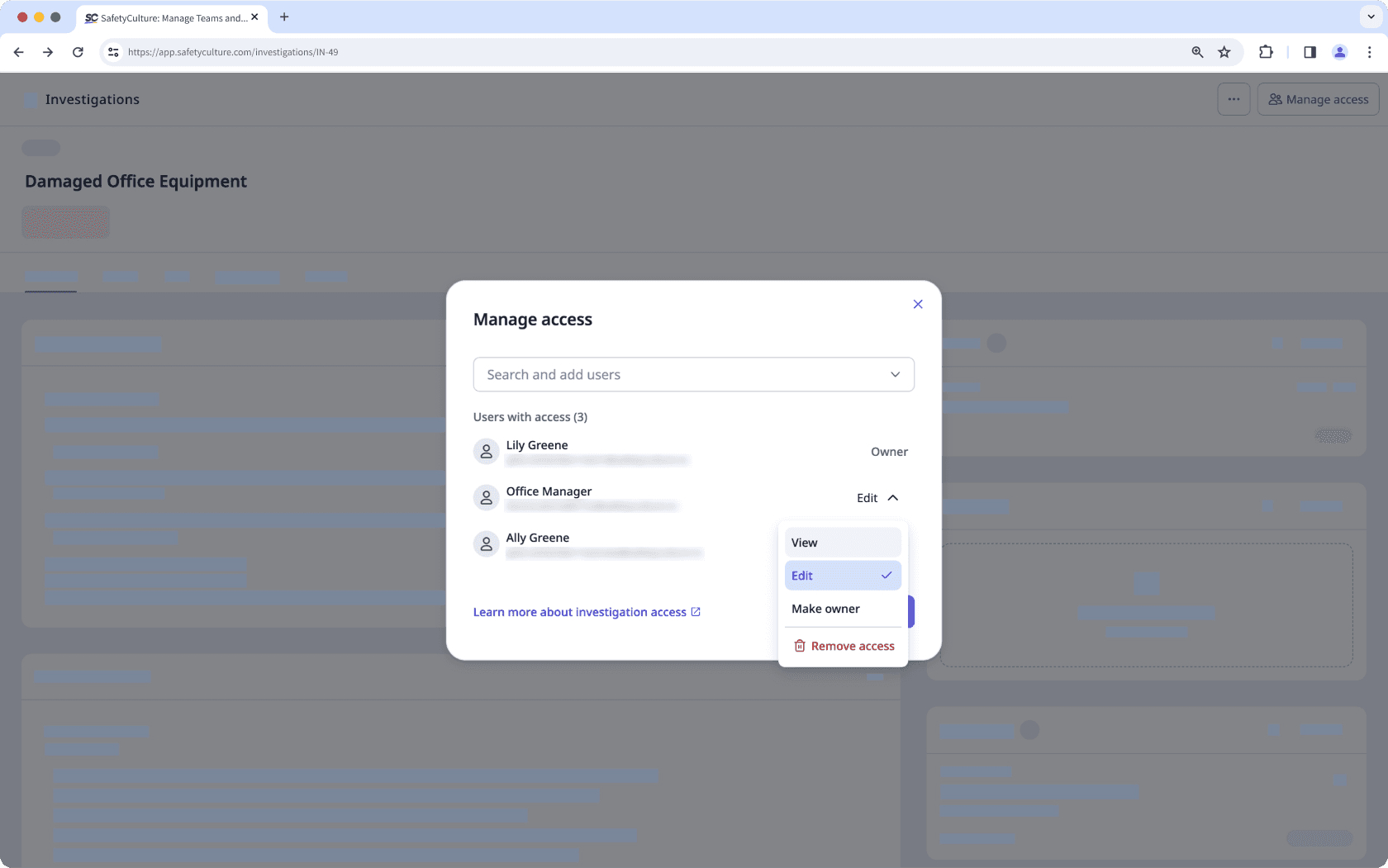- Utiliser SafetyCulture
- Enquêtes
- Commencez avec Enquêtes
Commencez avec Enquêtes
Découvrez comment faire commencer votre organisation avec la fonctionnalité Enquêtes de SafetyCulture.What are investigations in SafetyCulture?
The Investigations feature in SafetyCulture is designed to help teams streamline incident management by capturing key incident details, gathering evidence, and analyzing root causes. It allows you to customize workflows with custom statuses, categories, detail fields, and sections, manage granular access for secure collaboration, and assign corrective actions to ensure timely and effective resolution.
You can also document and share detailed investigation findings with stakeholders for transparency and drive continuous improvement in incident prevention and response.
Commencer en tant qu'administrateur
Créer des statuts personnalisés
Une fois que vous avez défini les statuts d'enquête, votre équipe peut commencer à créer des statuts d'enquêtes pour votre organisation. Ces statuts représentent les différents stages d'une enquête.
Vous pouvez utiliser les statuts par défaut, tels que « Collecte des preuves », « Analyse de la cause profonde », « Remédiation », « et Clôturé », ou créer des statuts personnalisés qui correspondent au flux de travail de gestion des incidents de votre équipe. La configuration préalable des statuts appropriés permet à votre équipe de suivre de manière cohérente l'avancement des enquêtes et de les gérer efficacement.
Par exemple, si votre organisation appartient à l'industrie de la fabrication, la gestion des pannes d'équipement, des accidents du travail ou des incidents de production nécessite souvent des enquêtes approfondies. Les statuts personnalisés vous aident à mettre en place un processus d'enquête qui correspond à vos protocoles de sécurité, à vos étapes de contrôle qualité et à vos flux de travail opérationnels.
Créez un champ de description personnalisé
Une fois vos statuts définis, vous devez créer des champs de description personnalisées afin de définir les détails clés de l'incident que votre équipe doit saisir au cours du processus d'enquête. Ces champs apparaissent automatiquement lorsqu'une nouvelle enquête est créée et permettent d'uniformiser la manière dont les informations relatives aux incidents sont enregistrées au sein de votre équipe.
Vous pouvez commencer avec les champs par défaut, notamment Description de l'incident, Chronologie des événements, Personnes impliquées, Actions immédiates, Principales conclusions, Facteurs contributifs, Cause profonde et Impact potentiel, ou les personnaliser pour les adapter au flux de travail de votre équipe.
Gérez l'accès aux enquêtes
Une fois que vous avez défini les statuts d'enquête et les champs de description, votre équipe peut commencer à ajouter des enquêtes. L'accès à chaque enquête étant géré individuellement, il est important de contrôler qui peut les afficher ou les mettre à jour afin de protéger les informations sensibles et de garantir que les bonnes personnes sont impliquées.
Vous pouvez accorder à d'autres membres de l'équipe un accès de type « Afficher » ou « Modifier » afin que votre équipe puisse collaborer en toute sécurité. Ainsi, chacun ne voit que les enquêtes qui le concernent et peut prendre les actions nécessaires le cas échéant.

Commencer en tant que membre d'équipe
Pour aider votre équipe à résoudre les incidents, assurez-vous de vérifier les actions que vous pouvez prendre dans le cadre des enquêtes qui vous ont été communiquées afin de faire avancer le processus :
Vérifier votre accès
Avant de commencer à travailler sur des enquêtes, vérifiez que les bonnes enquêtes ont bien été partagées avec vous. Votre niveau d'accès détermine ce que vous pouvez voir et si vous pouvez mettre à jour les détails de l'enquête.
Si vous disposez d'un accès de type « Modifier », vous pouvez contribuer en ajoutant des détails sur l'incident, en mettant à jour le statut d'enquête et en téléchargeant des rapports. Si vous disposez d'un accès de type « Afficher », vous pouvez consulter les détails de l'enquête, mais vous ne pouvez pas apporter de modifications. Si vous ne trouvez pas l'enquête que vous recherchez, contactez votre administrateur pour demander l'accès.
Rassembler les preuves pertinentes
Collaborez avec votre équipe sur les enquêtes en remplissant les champs de description et en ajoutant des photos, des documents ou des vidéos pour capturer les détails essentiels de l'incident. Vous pouvez également ajouter des observations , des actions ou des inspections pertinentes à une enquête, soit lors de sa création, soit rétroactivement, afin d'obtenir une vue d'ensemble complète. Le fait de conserver toutes les preuves au même endroit aide votre équipe à améliorer la visibilité, à prendre des décisions éclairées et à garantir que les enquêtes sont approfondies, faciles à suivre et prêtes à être auditées.
Cette page vous a-t-elle été utile?
Merci pour votre commentaire.